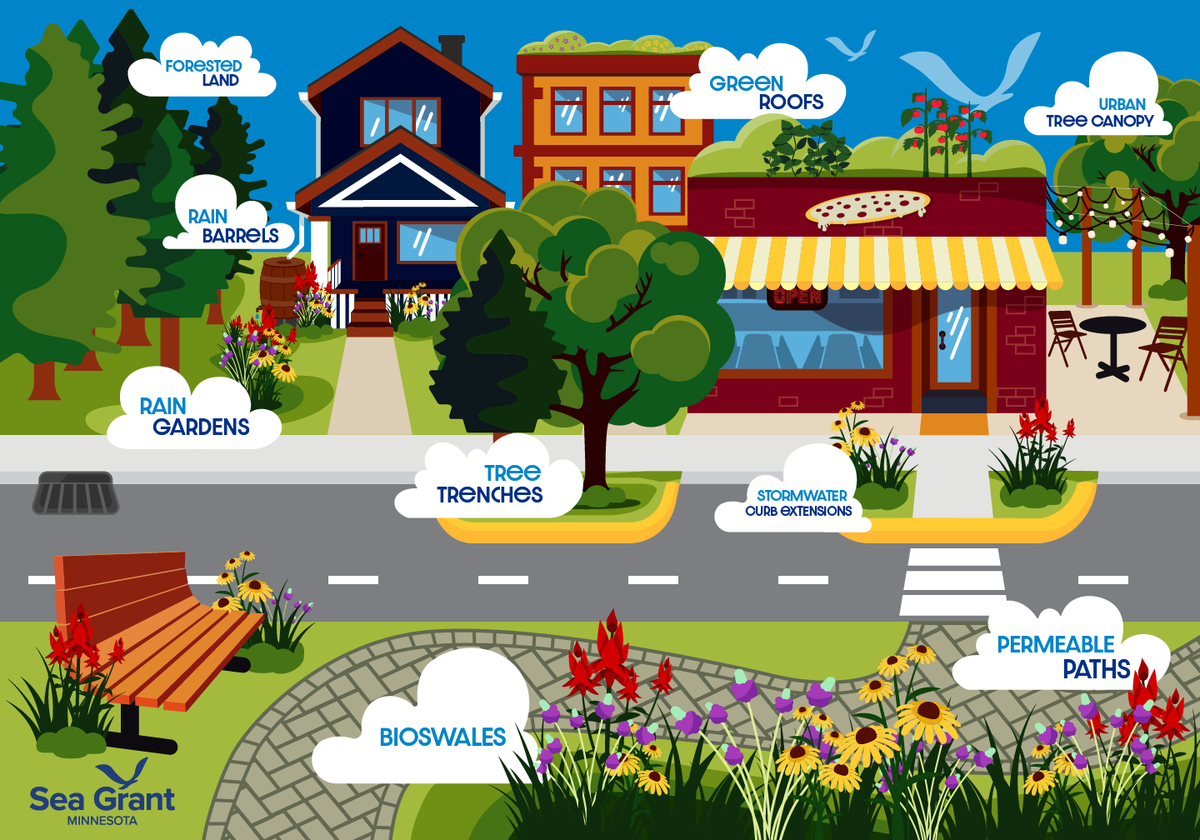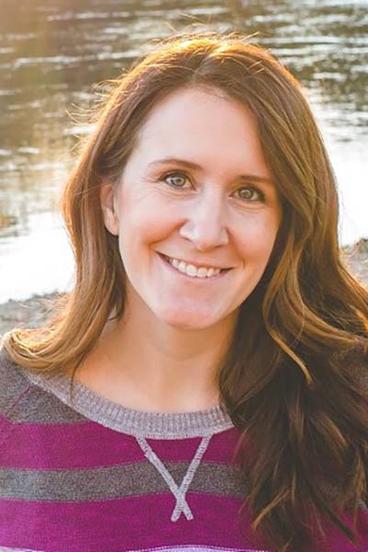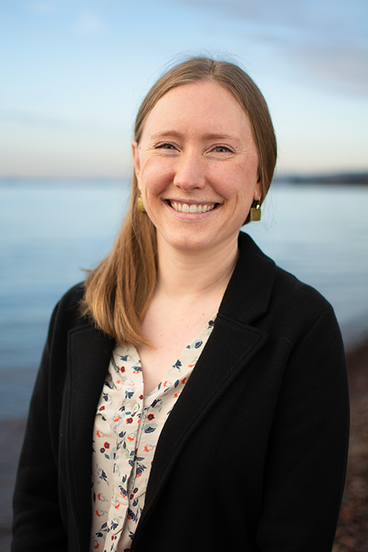Identifying and reducing regulatory barriers to using green stormwater infrastructure

Image credit: Cait Dettmann
Local codes and ordinances sometimes unintentionally prevent developers, businesses, and homeowners from choosing to use green stormwater infrastructure (GSI).
Minnesota Sea Grant, the University of Minnesota Duluth Natural Resources Research Institute (NRRI), and Birchline Planning LLC, teamed up to work with local governments to identify areas where code and ordinance updates might provide communities greater freedom to choose GSI and other nature-based solutions for managing stormwater.
Unintended barriers
Some local codes and ordinances create barriers to using GSI. These regulations may have drawn from the best practices available at the time they were adopted. Updating these regulations allows communities to incorporate the latest science and can be an opportunity to give local decision-makers greater freedom to choose practical solutions that are right for their communities.
Examples of unintended barriers to using GSI include:
- Requiring developers to provide more parking stalls than are necessary, which increases the cost of development while decreasing permeable surface area.
- Requiring high, uninterrupted curbing around parking lot islands, which prevents stormwater infiltration.
- Requiring mounded berms, which shed or divert water, to serve as visual screening around properties, instead of allowing landscape features that can double as stormwater retention features.
Green stormwater infrastructure in rural communities
Below are examples of GSI practices that are applicable in rural areas:
- Require vegetated shoreline buffers for lakeshore developments
- Strategically preserve wetlands, forests, and prairie lands for their stormwater retention benefits
- Adopt ordinances that include low-impact development standards and ecosystem planning principles for potential future subdivisions
- Enact locally specific construction erosion control regulations and permitting processes
Identifying and removing barriers
The project team worked with 13 local governments to identify and help them remove potential barriers to using GSI by:
- Reviewing existing regulations, permitting processes, and internal procedures to identify potential barriers to using GSI
- Working with local government staff to draft suggested regulatory and procedural updates
- Developing outreach projects and materials that support local government’s watershed management objectives and that incorporate GSI.
Participating project communities include:
- City of Duluth
- City of Hermantown
- City of Proctor
- City of Rice Lake
- Cook County
- Gnesen Township
- City of Grand Marais
- Lake County
- Lakewood Township
- Midway Township
- Normanna Township
- Thomson Township
- St. Louis County
+
Glossary
- Berm: An artificial ridge or mound of earth
- Climate adaptation: The process of preparing for and adjusting to the current and projected impacts of climate change
- Code: A systematic collection of statutes. For example, a zoning code is made up of all the municipality’s ordinances pertaining to zoning, while their building code contains all of their ordinances related to buildings.
- Ecosystem planning: An approach to planning new developments that considers existing natural areas and drainage-ways
- Evapotranspiration: The process by which water is transferred from the land to the atmosphere by evaporation from the soil and other surfaces, and by transpiration from plants.
- Green stormwater infrastructure (GSI): Any stormwater management practice that mimics or utilizes natural functions of the water cycle to capture rainwater where it falls, reducing runoff and treating stormwater at its source. Examples include rain gardens, rain barrels, or wetlands.
- Hydrologic: Having to do with the properties, distribution, and circulation of water on and below the earth’s surface
- Impacts of climate change: The effects of climate change (global annual average temperatures continuing to increase over time). For example, impacts of climate change include more frequent heavy precipitation events and increased risk of flooding; longer, more intense droughts; rising sea levels; earlier or longer fire seasons
- Infiltration: The process by which water flows into and through the subsurface soil
- Low-impact development (LID): Systems and practices that use or mimic natural processes that result in the infiltration, evapotranspiration, or use of stormwater in order to protect water quality and associated aquatic habitat. LID is sometimes used interchangeably with GSI.
- Nature-Based Solutions: Practices or strategies that address societal challenges by protecting, sustainably managing, or restoring natural and modified ecosystems, benefitting human and non-human systems at the same time. LID and GSI are examples of nature-based solutions.
- Ordinance: a regulation passed by a municipality, such as a city, village, or town
- Permeable: Having pores or openings that allow liquids to pass through
- Retention: holding back or storing something (for example, water)
- Retention and reuse: Holding back or storing water for beneficial use at a different time than when the stormwater was generated
- Shoreline buffer: an area adjacent to a body of water that is either left undisturbed (preserving an intact shoreline ecosystem) or planted with appropriate species, to help protect the water
- Swale: a shallow channel with gently sloping sides
- Transpiration: The process of giving off vapor, containing water and other waste products, through the stomata (pores) on leaves or the pores of the skin
+
Why Minnesota Sea Grant?
The green infrastructure code and ordinance project supports Sea Grant's mission to enhance the practical use and conservation of coastal, marine and Great Lakes resources by addressing barriers to using green infrastructure in the western Lake Superior region. Specifically, this project primarily supports our national and state focus area of resilient communities and economies. The project also builds on prior Wisconsin Sea Grant work described in the Tackling Barriers to Green Infrastructure: an Audit of Local Codes and Ordinances Workbook.
+
What have we done lately?
- September 2024: The Code Audit team hosted the Nature-Based Solutions for Northern Climates: Making Vegetated Stormwater Practices Work training.
- Team members presented about this project at the following recent conferences and events:
- October 2024: Water Resources Conference
- May 2024: Twin Ports Freshwater Folk Poster Session
- March 2024: St. Louis River Summit
- October 2023: Midwest Climate Resilience Conference
- The Code Audit project conducted community engagement and outreach about this project at the following events:
- August 2024: Midway Township National Night Out
- June 2024: Which plants should I plant webinars with Cook County Higher Education
- Summer 2024: Project team has prepared and delivered draft updated ordinance language with the City of Duluth and Midway Township. They will be meeting with local government and planning commission staff in September and October to share final project results.
- Summer 2024: The project team have begun work with Cook County, Lake County, and the City of Grand Marais as part of our phase 2 efforts.
- Summer 2024: The project team has developed additional outreach materials to support our communities needs including: a residential shoreline regulation flier, a flier to support choosing the right plant species for a project, and an inspection form to support land disturbance permitting.
+
Project team
- Madison Rodman, project lead, resilience extension educator, University of Minnesota, University of Minnesota Duluth, Minnesota Sea Grant.
- Jessy Carlson, resilience extension associate, University of Minnesota, University of Minnesota Duluth, Minnesota Sea Grant.
- Tiffany Sprague, organizational development manager, University of Minnesota Duluth, Natural Resources Research Institute.
- Juli Beth Hinds, principle, Birchline Planning LLC.
+
Funding
The Minnesota Sea Grant-led Code Audits & Community-Government Partnerships project is funded by the National Sea Grant Office, FY22 Coastal Adaptation and Resilience Opportunity. Award #NA22OAR4170098, Amendment 5, $125,000. The project started 8/1/22 and ends 1/31/24.
+
Project history
2024
- March 2024: Project team published Green Stormwater Infrastructure Code Audits: Updating Local Regulatory Structures for a Changing Climate.
- March 2024: Project team presented Green Stormwater Infrastructure Code Audits: Updating Local Regulatory Structures for a Changing Climate at the St. Louis River Summit.
2023
- October 2023: Minnesota Sea Grant Resilience Extension Associate Jessy Carlson will present on this project at the Midwest Climate Resilience Conference in Duluth, Minnesota.
- September 2023: The Code Audits & Community-Government Partnerships project team held midpoint project meetings with City of Duluth staff, Midway Township Planning and Zoning Committee, and the Duluth Urban Watershed Advisory Committee to share progress and collaborate on next steps.
- September 2023: The Code Audits & Community-Government Partnerships project team is building relationships with additional communities along Minnesota’s Lake Superior shore to scope which communities are interested and would benefit from a green infrastructure code and ordinance audit.
- August 2023: The Code Audits & Community-Government Partnerships project team has begun planning for a spring 2024 green infrastructure professional development training in collaboration with the Lake Superior National Estuarine Research Reserve.
Program Staff
Media Mentions
- NOAA Sea Grant Advances Resilient Coastal Communities with $4 Million in Support National Sea Grant College Program


